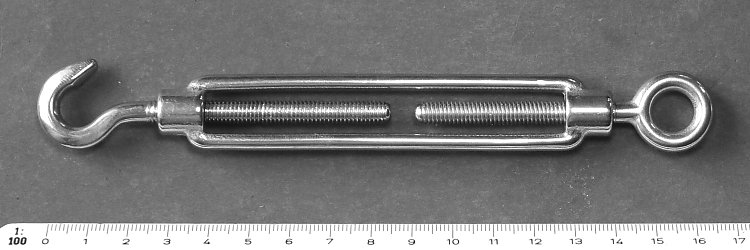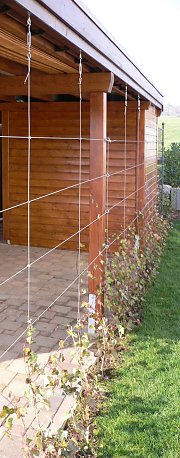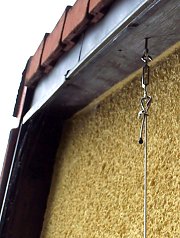Product sheet
Description / Price
Simple rope tensioner / tightening screw made of stainless steel A4 (AISI 316) with hook and eye, open design, with right and left-hand thread, M6, length approx. 160 - 230 mm, max. tension distance 7 cm, jaw width of hook approx. 7,5 mm. >>> Price
Use
As a cable tensioner in wire and cable trellises. The open hook SP 06230 is hung directly, i.e. suspended without further connecting elements, in wall eyelets from FassadenGrün. The hook into the ground anchors requires a circular ring (an 'O-ring') as a link/intermediate element. For wire and cable up to approx. 3 mm diameter. In the case of high vertical cables, you'll need to consider whether the tensioner should be installed at the top or bottom. A high installation is tamper-proof and therefore preferable in public street areas. But the advantage to lower installations is that the tension screw is more accessible if re-tensioning is required. Please refer to thegeneral information on the use of cable clamps and tensioners, etc.. for extra support when needed.
Installation
Before installing the cable tensioner, unscrew the eye and hook from the device until there is only 1 cm left of thread to turn (so, 1 cm protrusion into the sleeve). (Attention: right-hand AND left-hand thread!) First tension the cable lightly; then apply turnbuckle. Then tension can be achieved with few turns of the tension sleeve. Use an awl (mandrel), nail, screw, or the like, and insert it through the center of the sleeve. The sleeve is rotated so that both threaded shafts pull inwards evenly. Both are then screwed into the sleeve with about half the thread length; this gives a harmonious appearance, and there is still enough space for any re-tensioning that may be required later.
Special Features
FassadenGrün cable systems are usually designed economically such that the installation of tensioning elements is unnecessary. For Easy Kits without cross mounts (specifically: when there are many deflection points and also for long individual cables without decoupling the cable sections), cable tensioners are sometimes recommended. The number of tensioners in a climbing system can be reduced by a sensible arrangement and networking/cross-linking of the cables. In most cases it is possible to combine at least two ropes with each other via deflection and to incorporate the cable tensioner in their centre, it being then 'responsible' for both ropes.
Origin
Imported (the Far East)



